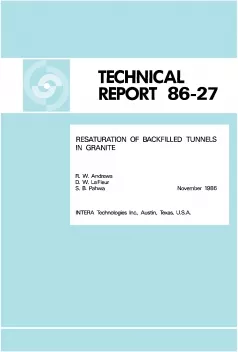
Technical Report NTB 86-27
Resaturation of backfilled tunnels in granite
Highly compacted bentonite clay is proposed for use as a backfill material around high level waste overpacks to be placed in excavated tunnels in the crystalline bedrock of Northern Switzerland. Initially the bentonite will have low residual water content and with time the bentonite will resaturate due to the influx of water from the crystalline rock. The time and degree of bentonite saturation are important for safety assessment because of their effect on the corrosion of the waste overpack, on the leaching of the waste matrix, and on the radionuclide transport in the backfill. A three-dimensional, two-phase flow model (FAMOS) is used to quantify the expected resaturation under the conditions outlined above.
The time required for complete saturation simulated using FAMOS ranges from less than 100 to more than 1000 years. These results are comparable to the results of diffusive models of bentonite saturation when using a diffusion coefficient of 3 × 10-10 m2 s1. The time depends on the hydraulic properties of the bentonite as well as on the saturated hydraulic conductivity of the crystalline rock. At saturated granite hydraulic conductivities of the order of 10-9 m s1 the bentonite becomes fully saturated in less than 100 years. For saturated granite hydraulic conductivities in the order of 10-12 m s-1 the bentonite becomes fully saturated in several hundred to over 1000 years. For a given granite hydraulic conductivity the degree of saturation depends on the bentonite capillary pressure versus water saturation characteristic relationships. For high capillary pressures (in the order of 105 kPa) the bentonite saturates relatively quickly, with lower capillary pressures the time for complete saturation increases.
One-dimensional resaturation of a cylindrical bentonite sample was simulated using FAMOS; the results were compared with those of measurements obtained by Nagra. Sensitivity analyses were performed by varying the saturated bentonite hydraulic conductivity from 10-13 m s-1 to 10-14 m s-1, the characteristic capillary pressure versus water saturation relationship and the characteristic relative permeability versus water saturation relationship. Using a capillary pressure versus saturation relationship as deduced from measurements of the water vapour adsorption isotherms of bentonite and a dry density of 1.92 Mg m-3 yielded a best estimate for bentonite hydraulic conductivity of 2 × 10-14 m s-1, which is in the same order of magnitude as that observed by other researchers in Sweden, Switzerland and the USA.
